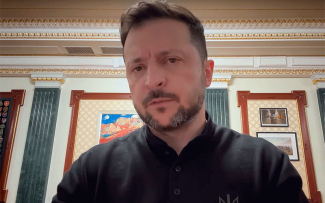Mutual accusations of non-compliance with the truce. Day 1155 of the war


On 19 April, Vladimir Putin announced an Easter truce, which was to include a cessation of all hostilities from 6 p.m. on 19 April until midnight between 20 and 21 April. He stated that he expected Ukraine to follow Russia’s example and join the truce. His proposal was made in response to announcements by US President Donald Trump and Secretary of State Marco Rubio that the US would cease further attempts to negotiate a peace agreement between Moscow and Kyiv if there were no clear signs in the next few days that one was possible.
President Volodymyr Zelensky reported that during the 30-hour truce, the enemy violated the ceasefire almost 3,000 times and carried out 96 infantry assaults on various sections of the front and 950 drone attacks. Putin, on the other hand, claimed that during this time the Ukrainians violated the ceasefire 5,000 times and carried out 100 strikes using drones.
Over the past week, fighting has been taking place along the entire front line, with the area of greatest intensity being the Pokrovsk direction and around the route to Kostiantynivka in Donetsk Oblast. According to Ukrainian Army’s Commander-in-Chief General Oleksandr Syrskyi, south of Pokrovsk (in the area of Udachne, Kotlyne and Shevchenko) Ukraine successfully counterattacked. Russia, however, pushed them out from the area of the villages of Sukha Balka and Kalynove, located next to the road leading to Kostiantynivka – an important logistical junction. According to reports from the Ukrainian side, Russia has stepped up its use of drones, which they previously likely used in Kursk Oblast. Russian forces have also made advances towards Lyman, where they seized Katerynivka, as well as on the Zaporizhzhia direction in the Zaporizhzhia area of the town of Kamienske. According to the Chief of General Staff of the Russian Armed Forces, Valery Gerasimov, they managed to push the enemy out of almost the entire Kursk Oblast. Kyiv claims that Ukrainian troops are still defending themselves in the border area south of the towns of Oleshnya and Guyevo.

A 30-day bilateral moratorium on air attacks on energy infrastructure ended on 18 April. Ukrainian Foreign Ministry spokesman Heorhiy Tykhyi announced that between 25 March and 16 April, Russian forces had violated the so-called energy truce more than 30 times. Three incidents – involving damage to transformers in the Mykolaiv region and on the outskirts of Kherson and a transmission line in the Poltava region – were reported during the final day.
Russia carried out massive drone attacks on Odesa (16, 19, 21 and 22 April), Dnipro (16 April), Mykolaiv (17 April), Sumy (18 April), Zaporizhzhia (19 April), Poltava and Kharkiv (22 April). It used guided bombs in air attacks on Kherson (16 April), Izyum (16 and 19 April), Dnipro (18 April) and Zaporizhzhia (21 April). Also on 21 April, Russian missiles fell on Mykolaiv’s residential areas, while three days earlier, ballistic missiles struck one of Kharkiv’s residential areas. The attack left one person dead and 113 injured. On 23 April, in the village of Marhanets in Dnipropetrovsk Oblast, drones hit a bus carrying employees of one of the companies. At least nine people were killed and 42 injured.

On 22 April, an explosion occurred at one of the Russian Ministry of Defence’s largest ammunition depots – the 51st Arsenal of the Main Rocket and Artillery Board located near the village of Barsovo in Vladimir Oblast. According to available data, the depot may have held more than 100,000 tonnes of ammunition, including Iskander and Tochka-U missiles and missiles for the S-300, S-400, Grad, Smerch and Hurricane systems. The Ukrainian government has so far not confirmed its involvement in the attack, while the Russian defence ministry said the explosion was the result of a “violation of safety rules during the handling of explosives”. The Ministry of Emergency Situations of the Russian Federation has declared a state of emergency in the Kirzhachsky district where the arsenal is located and local authorities have evacuated several surrounding villages.
On 16 and 17 April, Ukrainian armed forces carried out a drone attack on military facilities of the Russian Army’s 112th Guards Missile Brigade in the town of Shuya in the Ivanovo region – a barracks building was damaged. According to the Ukrainian side, this unit was allegedly responsible for the criminal rocket strikes on Sumy on Palm Sunday, 13 April.
On 19 April, the Ukrainian Air Force carried out a strike on enemy military facilities in the village of Tyotkino, Kursk Oblast, which were intended to equip and launch reconnaissance drones and train their pilots. The General Staff of the Ukrainian Armed Forces reported the elimination of 20 drone operators.

On 17 April, Germany updated the list of military aid delivered to Ukraine. Kyiv was to receive: 66 MRAP armoured vehicles, ammunition for Leopard 2 tanks, 38,000 rounds of ammunition for Gepard self-propelled anti-aircraft guns, missiles for IRIS-T air defence systems, three Zuzana 2 wheeled self-propelled artillery systems (in cooperation with Denmark and Norway), 27,000 155 mm shells, 1,000 122 mm missiles, 70 VECTOR UAVs with spare parts, 150 HF-1 UAVs, ten unmanned surface drones, six Bergepanzer 2 armoured evacuation vehicles with spare parts and four mine clearance vehicles.

The Ukrainian defence ministry announced on 16 April that the Defence Procurement Agency has concluded contracts with 76 domestic drone manufacturers and allocated more than 104 billion hryvnias (about $2.5 billion) for the period 2024–2025. In addition to this, a government grant programme has been launched, offering manufacturers up to 8 million hryvnias (about $200,000) to purchase equipment and components, provided they meet transparency requirements and have no links to Russia.
On 19 April, another 246-for-246 exchange of prisoners of war took place on the border with Belarus, with the Russian side handing over an additional 31 people requiring hospital treatment. The overwhelming majority of those released are young people, born in the current century. A total of 4,552 people have returned to Ukraine from captivity since March 2022.
On 22 April, the Cabinet of Ministers of Ukraine approved a procedure for the creation of centres for training citizens for the National Resistance, developed by the Ministry of Defence in cooperation with the Office of the President. Their tasks will include preparing as many citizens as possible for armed resistance, shaping patriotic attitudes and learning the practical skills necessary to defend the country. The centres will be set up in all districts, with funding provided by local authorities and businesses. The instructors will be mainly veterans and the training will be based on programmes that take into account regional specificities. The decision to set up the training centres shows that the authorities consider the scenario of a quick end to the armed conflict unlikely and are pursuing projects to strengthen their own military potential.

On 16 April, Reuters reported that between September 2023 and March 2025. North Korea delivered between four and six million artillery shells to Russia. They were transported by sea and rail, including using Russian ships that carried nearly 16,000 containers from the port of Rajin to the Russian port of Vostochny in the Far East. In addition to artillery shells (mainly 122 mm and 152 mm calibres), Pyongyang handed Moscow multi-launcher rocket launchers, self-propelled artillery stations and ballistic missiles.
President Zelensky continues to criticise the Chinese authorities – accusing them of providing military support to the Russian Federation. Following allegations on 8 April that at least 155 Chinese citizens were serving in the Russian military, he stated on 17 April that Beijing was supplying Moscow with artillery ammunition and gunpowder and supporting arms production on Russian territory. He also stressed that Xi Jinping had provided assurances that China would not supply arms to Russia. On 22 April, Ukrainian Deputy Foreign Minister Yevhen Perebyinis, in a meeting with the Chinese Ambassador Ma Shengkun, stressed that the participation of the country’s citizens in hostilities on the Russian side, as well as the involvement of Chinese companies in military production in the Russian Federation, raise serious concerns and contradict the spirit of partnership between Kyiv and Beijing. He added that evidence of these facts had been provided to the Chinese side by the Ukrainian intelligence services. As a result, the Ukrainian side called on the Chinese authorities to take action to stop assisting Russia in its aggression.
The open criticism of the Chinese authorities is an attempt to force Beijing to make it clear that strategic cooperation with Moscow does not include military support directly affecting the situation on the Ukrainian front.
Zelensky’s statements were rebutted by the Chinese Foreign Ministry. On 18 April, it rejected the president’s accusations, deeming them “baseless”, and ministry spokesperson Lin Jian asserted that China has never supplied lethal weapons to any party to the “Ukrainian crisis” and strictly controlled dual-use exports. It is possible that, annoyed by this narrative, Beijing may restrict drone exports to Ukraine. On 22 April, the State Customs Service of Ukraine reported that between January and March this year. Kyiv imported 127,800 civilian drones worth $371.3 million. China remains their main supplier – providing 98% of the imported machines and components.





